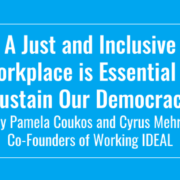10 Ways to Foster an Inclusive Workplace Culture
Many employers understand the importance of assessing their workplace culture and the need to promote inclusion. An inclusive workplace culture offers benefits to both employers and employees by fostering engagement, productivity, retention, and innovation. In an inclusive workplace, all employees are treated with respect and have an opportunity to contribute. An inclusive workplace accepts and values individual differences in race, ethnicity, religion, national origin, sex, gender identity or expression, sexual orientation, age, and disability.
By contrast, exclusion in the workplace leaves workers feeling marginalized and devalued. Disrespectful behavior that goes unchecked can lead to a toxic environment, particularly when workers do not have sufficient options to report, address, and resolve workplace problems. This dysfunction in the workplace may cause talented employees to leave the organization. Exclusion can take many forms. Some employers fail to convey a commitment to organizational values. Employers may fail to set clear expectations about appropriate conduct. Gaps in policies, benefits, technology, and training can exacerbate internal problems. Employers may be unaware of problems with the workplace culture because they fail to seek feedback.
To avoid these problems, employers can take concrete steps to promote inclusivity in meaningful ways.
- Lead from the top. Leaders must visibly model respectful behavior and practice organizational values. Managers should promote inclusion at all levels and across all departments.
- Put clear expectations in writing. Employers can establish a code of conduct and recommit to organizational values. The strategic plan should promote inclusion, and the employer should periodically evaluate progress toward meeting stated goals. Job descriptions and performance evaluations can address responsibilities to promote diversity, equity, and inclusion.
- Seek input and value contributions from diverse talent. The organization must go beyond simply ensuring that it employs a diverse workforce. Everyone should have a seat at the table. Seeking out diverse perspectives helps to amplify marginalized voices. Working groups and teams should include a diverse cross-section of the workforce.
- Assess the culture regularly, accept critical feedback, and take action to address concerns. Anonymous surveys, focus groups, and informal discussions can help to identify concerns about the workplace climate and potential solutions. Employers should ensure that a diverse cross-section of the workforce is involved in identifying problems and implementing responses. Inclusion should be a regular focus of discussion.
- Ensure that employees have accessible options to report, address, and resolve workplace problems. Managers may not be aware of problems that go unreported. Employees must have trusted and effective channels to report concerns.
- Ensure accountability. Employers must act quickly to address problems at all levels within the workplace.
- Update policies to use inclusive language and make the workplace more welcoming. For example, employers should review benefits policies to ensure equity for LGBTQ+ employees and offer opportunities for employees to provide the pronouns they use.
- Build a culture of accessibility for applicants and employees with disabilities. Employees with disabilities should have access to any needed technology or other accommodations, but don’t wait to be asked. Make accessibility a regular part of planning for meetings, events and activities, and standard workplace practices.
- Foster inclusivity in informal situations. Workers may feel excluded when it comes to social situations at the lunch table, at happy hours, or even in casual conversations. Employers can seek to disrupt office cliques through team building opportunities.
- Offer training that provides tools and skills to address problematic behavior. Employers should move away from compliance-focused training to ongoing and regular education that equips workers with the knowledge and skills to take action. For example, bystander intervention training can equip workers with methods to act as an ally in support of a colleague who faces harassment or bullying.
By taking concrete steps to promote an inclusive workplace culture, employers can build a stronger workforce.
Working IDEAL provides trusted and innovative advice on inclusive workplaces, diverse talent, and fair pay. Contact us to learn more about the services we offer.
Author: Sarah Crawford











